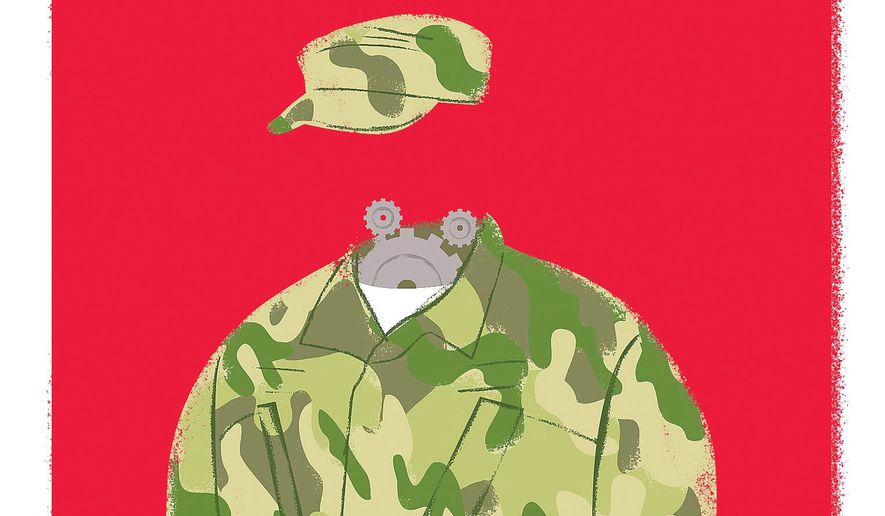OPINION:
Ignored by the “inside the Beltway” media has been the heroic efforts of Rep. Mike Rogers, Alabama Republican, as he struggles against the “corporate” Air Force to establish a separate Space Corps service.
Opposing Mr. Rogers, the secretary of the Air Force says a separate space service isn’t needed and that the regular Air Force can do whatever is necessary to fulfill the military space mission.
This is a huge load of some of Washington D.C.’s finest political trash.
You see, the Air Force, like most of the military services, is a highly political and bureaucratic organization from top to bottom, believing that its primary mission — the one that gets the most money and attention — is centered around the concept of manned aviation.
Not space, not intercontinental ballistic missiles (ICBM), not remotely piloted vehicles (RPV) nor drones, but manned aviation — airplanes with pilots in them, male or female.
While this penchant has changed focus over the years, it’s been primarily about the specific kind of manned aviation. In the 1950s and ’60s it was bombers — and successions of Air Force senior leadership came from the old Strategic Air Command (SAC) with the primary budget emphasis on nuclear bombers and their tankers. The need for air defense and ICBM systems took a back seat to the SAC’s manned mission, which was pilot-centric.
But this changed, and the Vietnam War switched the focus from bombers to fighters. Sure, bombers were still important, but fighter pilots took over the senior leadership of the Air Force and have not let go of it — Iraq has made it even more evident.
However, what do bombers and fighters have in common? They both are manned systems. Space is not, ICBMs are not, drones and RPVs are not. So the big money in the Air Force budgets still goes to operate and logistically support the manned aviation mission.
Not just picking on the Air Force here, even though the Space Corps issue is just the latest one that reveals this basic truth: While the Air Force says it wants the space mission, it really wants the big budget money for it more than anything else. And this is nothing new — the same dynamic goes back as long as there has been a military space mission.
Why is this so critical today — especially in light of the North Korean nuclear and ICBM threat? Because, just for example, ballistic missile defense (BMD) is every bit as important as any other basic aerospace mission — and the most effective BMD defenses have most always been space-based or space-centric.
There is also general agreement that we have let our ICBM nuclear force atrophy since the end of the Cold War. This is another basic Air Force mission that is budgetarily subjugated to the money appropriated for the latest advanced manned systems, e.g., the F-35 fighter. The Russians have not allowed this to go unnoticed and have fielded generations of new ICBMs while ours are based on 1970s technology.
Do the other services have their internal mission and budget struggles, too? Certainly:
• The Navy has perennial tensions between surface warfare, submarines and aviation. While this was perhaps at its peak with the struggles with Adm. Hyman Rickover and his advocacy for the “nuclear Navy,” especially nuclear-powered ballistic missile submarines, these budget battles continue. Also, depending who is the current chief of naval operations — and more importantly, whether he is an aviator, submariner or a surface warfare officer — the Navy’s budget and mission emphasis is directed accordingly.
• The Army isn’t immune. The traditional factions in the Army are infantry, armor and artillery. Army aviation is too often regarded as an unwanted stepchild when pitted against the budgets of the big three. A good question today is how these traditional missions square with the terror threat and why isn’t the Army focused primarily on special operations.
• We all love the Marines, and they have perhaps the least amount of internal mission-budget politics of any service. Yet they remain technically part of the Navy, where they compete against naval aviation for operational and budgetary relevancy.
How should we address these complex issues?
First: Create a Space Corps. Let’s finally get serious about the military space mission. Opposition to this is based on age-old and internal Air Force emphasis on manned aviation. This is the same basic concept as to why the Air Force was pulled out of the Army and established as a separate service in 1948.
Second: After World War II the armed services were reorganized by the “roles and missions” assigned to them by the Key West Agreement — and we need to do it again. Times have changed dramatically and we need a military that’s organized around the current threats we face — not traditional budget and mission preferences. Let’s get some very smart people in a room and keep them there until they come up with an organizational structure that makes sense.
In short, it’s past time for a Key West 2.0.
• Daniel Gallington served in the U.S. Air Force, senior national security policy positions in the Office of the Secretary of Defense, the Department of Justice and as general counsel for the U.S. Senate Select Committee on Intelligence.




Please read our comment policy before commenting.